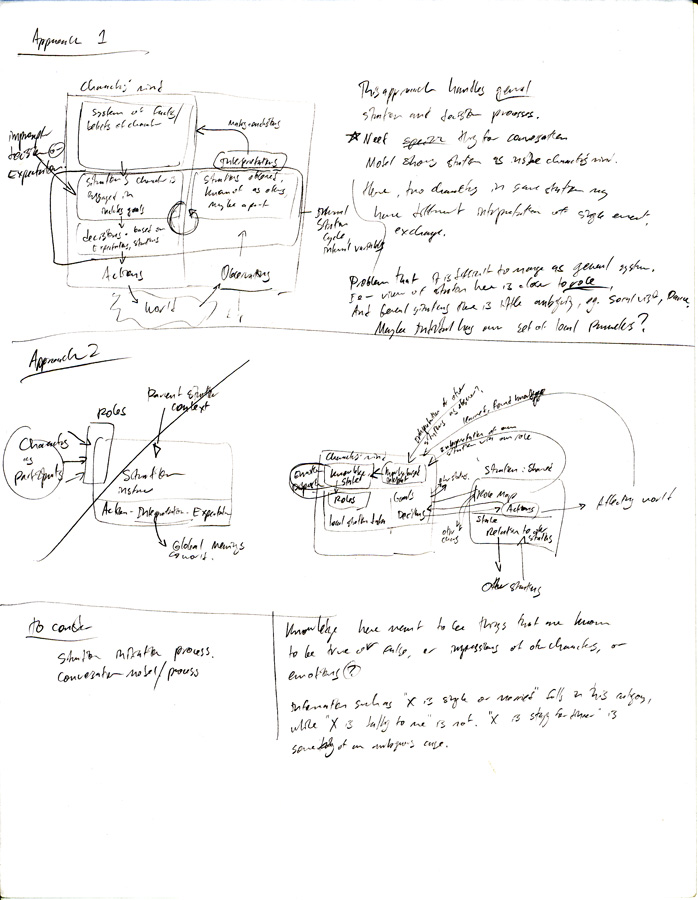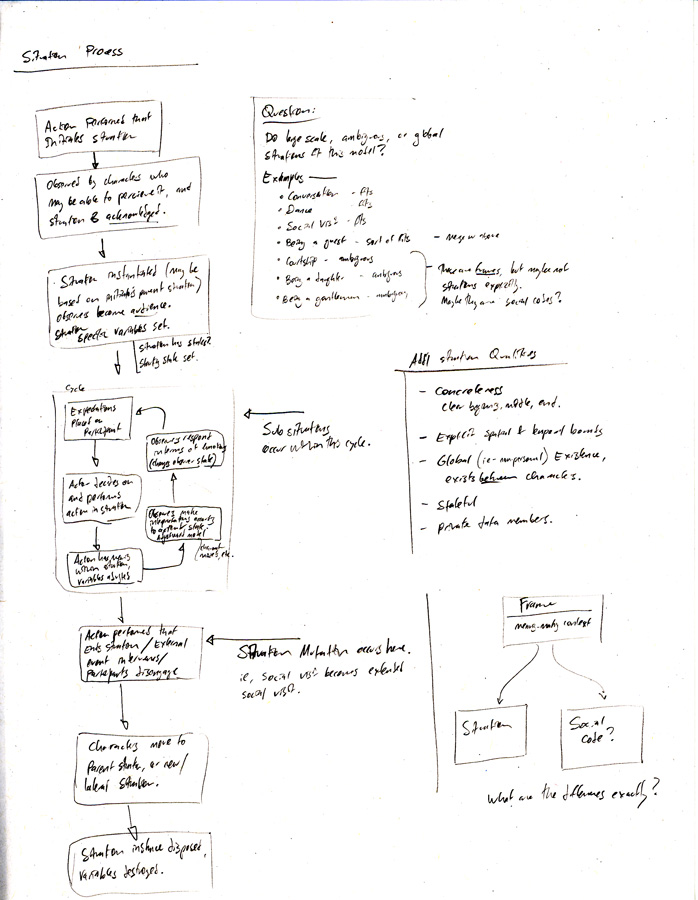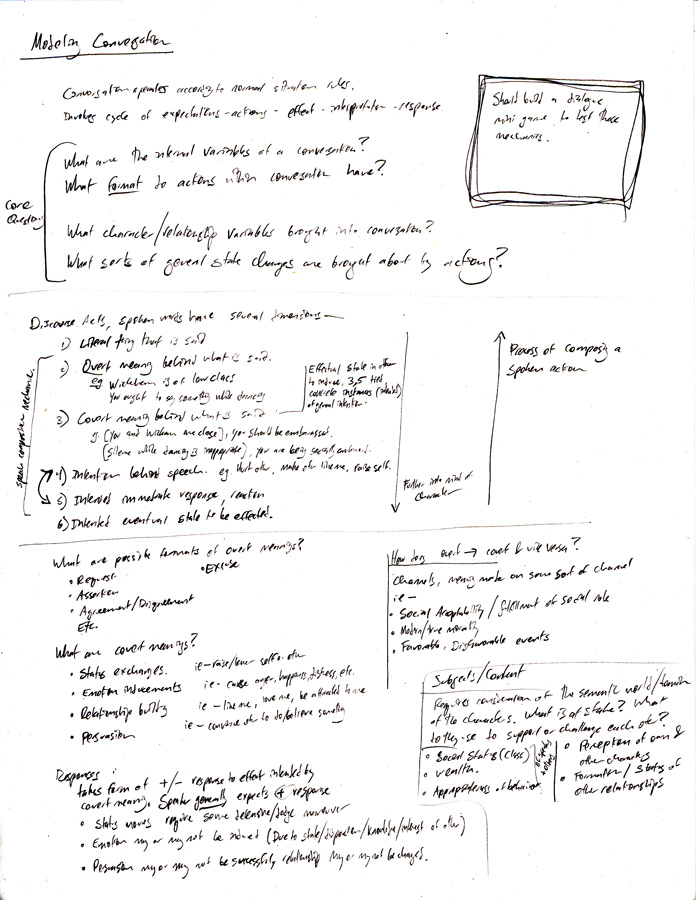Possible Worlds is an intersection between narrative theory and AI. In this book, narrative is deeply tied to fiction, and it is in fiction that the idea of story worlds most clearly emerges. In order to understand the ways that fiction can work, Ryan turns to the theory of possible worlds. This is motivated by a need to turn to new ideas in the scope of formalist narrative theory, as other formalist approaches have begun to run dry, specifically the semiotic square and generative grammars.
The theory of possible worlds is introduced as a logical model. This depends on 1) the semantic domain of a text, and 2) the modal operators that define states. In narratology, the theory of text as a world is relatively familiar. Specifically mentioned are Alvin Plantinga and Robert Merrihew Adams. In this dimension, the theory of possible worlds is preoccupied with structure and also the matter of truth in fiction, namely what statements can be classified as true in a world. This sort of reasoning echoes the domain of formal logic, which connects the theory to AI.
The motive behind the actual use of the grammars is partly shared with AI, the other influence on this book. AI has several influences on the discussion of narratives. The use of AI as an approach treats the text and plot as something comparatively definable. Ryan rejects the idea that meaning is some sort of ethereal in inscrutable phenomenon, but instead argues that it resembles something more of a definable system. “The fundamental belief is that the creation of meaning is not a mysterious brainstorm caused by a random meeting of circumstances–a unique individual in an ephemeral state of mind, nurtured to some immesurable extent by a culture whose boundaries remain fuzzy, and bringing to the text a deeply private experience of the world–but the predictable output of definable processes operating on a variable input.” (p. 9-10)
This is somewhat disconcerting, as I agree with the basic premise of possible worlds, but I do not agree with this statement. Or, rather, the way that meaning is made can be procedural, but all AI projects that have sought to acommodate the sort of commonsense and everyday processes that go into interpretation or even comprehension of a text have met with severe handicaps. Most of them have failed to produce anything of value or substance, and it is thus hard to imagine that fruit can be gained by turning to the same assumptions that AI imposes on the world and applying those to narrative theory.
Part of the problem is that Ryan’s motivation to use AI comes from an interest in the generation of stories, an aim that I do not share within my research. My approach has sought to look at story worlds as having meaning within a particular context, and simulating that space of meaning, leaving the problem of interpretation on the side of the human participant, rather than attempting to include it in the system itself.
Fictional Recentering
One of the roots of possible worlds comes from Leibniz, who considered that there were an infinite number of possible worlds, but only one that was actual, the best of them all that was chosen and instantiated by God. Here, Ryan introduces the logical roots of possible worlds, considering them as systems of propositions, which may or may not be true. When these are arranged in large sets of all possible truth conditions, this creates a semantic universe, a term introduced by Kripke.
Fictional (possible) worlds are mental constructions. Ryan compares the theories of Rescher and David Lewis. Rescher considers that all possible worlds exist, because they can be imagined. In this theory, the possible worlds mut be considered as totally knowable and factual (in the sense that all the facts of the world are known). Lewis, whose outlook Ryan seems to favor, considers there to be an indexical theory of how we relate to possible worlds. The worlds in Lewis’s view are not fully known and determined by experience.
Ryan makes an interesting comparison between possible worlds and games. Make believe games are characterized by many rules of substitutions (where one object represents another). Fiction emphasizes only one substitution, that the narrated world is really the actual world. Both of these make use of the magic circle, where outside of the circle, the rules for understanding occurrences and experience are normal, but inside the reader or player employs rules to develop meaning and understand the world. Textual worlds make use of several axioms: (p. 24-25)
- There is only one AW.
- The sender (author) of a text is always located in AW.
- Every text projects a universe. At the center of this universe is TAW.
- TAW is offered as the accurate image of a world TRW, which is assumed (really or in make-believe) to exist independently of TAW.
- Every text has an implied speaker (defined as the individual who fulfills the felicity conditions of the textual speech acts.) The implied speaker of the text is always located in TRW.
These terms come from the glossary of terms before the introduction of the book: (p. vii)
- System of reality: A set of distinct worlds. The system has a modal structure, and forms a modal system, if it comprises a central world surrounded by satellite worlds. The center of a modal system is its actual world, the satellites are alternative possible worlds.
- Textual universe: The image of a system of reality projected by a text. The textual universe is a modal system if one of its worlds is designated as actual and opposed to the other worlds of the system.
- Semantic domain: A concept slightly more general than textual universe. The set of concepts evoked by the text, whether or not those concepts form a system of reality (i.e., whether or not the text asserts facts and makes existential claims)
- AW: The actual world, center of our system of reality. AW is the world where I am located. Absolutely speaking, there is only one AW.
- APW: Alternative possible world in a modal system of reality.
- TRW: Textual reference world. The world for which the text claims facts; the world in which the propositions asserted by thte text are to be valued. TRW is the center of a system of reality comprising APWs.
- TAW: Textual actual world. The image of TRW is proposed by the text. The authority that determines the facts of TAW is the actual sender (author).
- TAPW: Textual alternative possible world. An alternative possible world in a textual universe structured as a modal system TAPWs are textually presented as mental constructs formed by the inhabitants of TAW.
- NAW: Narratorial actual world. What the narrator presents as fact of TRW.
Possible Worlds and Accessibility Relations
This section describes the logical relations of possible worlds. These worlds describe entire universes. They may abide by following some assortment of logical properties. These lay out the formal logic of the textual worlds. We could also consider these logical relations as rules for building possible worlds. The rules for considering the logical properties can vary depending on whether the world operates according to concrete logic, dream logic, nonsense logic, and so on. The different properties are given below: (p. 32-33)
- (A) Identity of properties. TAW is accessible from AW if the objects common to TAW and AW have the same properties.
- (B) Identity of inventory. TAW is accessible from AW if TAW and AW are furnished by the same objects.
- (C) Compatibility of inventory. TAW is accessible from AW if TAW’s inventory includes all the members of AW, as well as some native members.
- (D) Chrnological compatibility. TAW is accessible from AW if it takes no temporal relocation for a member of AW to contemplate the entire history of TAW. (This means TAW is not in the future of AW)
- (E) Physical compatibility. TAW is accessible from AW if they share natural laws.
- (F) Taxonomic compatibility. TAW is accessible from AW if both worlds contain the same species, and the species are characterized by the same properties. Within F, it may be useful to distinguish a narrower version F’ stipulating that TAW must contain not only the same inventory of natural species, but also the same types of manufactured objects as found in AW up to the present.
- (G) Logical compatibiltiy. TAW is accessible from AW if both worlds respect the principles of noncontradiction and of excluded middle.
- (H) Analytical compatibility. TAW is accessible from AW if they share analytical truths, i.e., if objects designated by the same words have the same essential properties.
- (I) Linguistic compatibility. TAW is accessible from AW if the language in which TAW is described can be understood in AW.
Reconstructing the Textual Universe
This section derives from David Lewis, coming from his investigation of counterfactuals. The notion of what is “true” in fiction is ambiguous. Complications arise in terms of what is known as fact, versus what is told as fact, or what is assumed or expected. The section introduces what is called the “principle of minimum departure”, which explains that a possible world is more likely if it has a sort of minimum distance from the actual world of the fiction. Ryan gives an algorithm for considering counterfactuals in TRW:
There is a set of modal universes A, which are constructed on the basis of a fictional text f, and in which whose actual world the nontextual statement p is true.
There is a set of modal universes B, which are constructed on the basis of a fictional text f, and in whose atual world the nontextual statement p is false.
Of all these universes, take the one which differs the least, on balance, from our own system of reality. If it belongs to set A, then p is true in TRW, and the statement “in TRW, p” is true in AW. Otherwise, p is false in TRW, and “in TRW, p” is false in AW. (p. 50)
An important part of minimum departure is interpretation, which often involves actual world construction. How does the reader build up the substance of the TRW based on limited knowledge? The textual world is necessarily an in complete picture of not only the world’s semantic universe, but also the world of the fiction itself. This is complicated by way in which facts may be interdependent in the TRW.
Considering TRWs as subjects for possible worlds (including counterfactuals) leasds to the development of a textual universe. This is what I am attempting to simulate in the Pride and Prejudice game.
The Modal Structure of Narrative
The actual content of a narrative is some system of events in a sequence, but the nature of these is much more than mere propositions. In addition to conveying actual events, narratives are concerned with events that are non-actual, not-yet actual, may-have-been actual, and so on. The way for communicating these is for them to be given in modes. This discussion is influenced heavily by Todorov and Doležel. Todorov gives four modal operators: (p. 110)
- Obligatory mode: events dictated by the laws of a society.
- Optative mode: states and actions desired by characters.
- Conditional mode: actions that characters will perfom if other events happen.
- Predictive mode: antipated events.
Doležel describes three systems of modes: (p. 111)
- The deontic system, formed by the concepts of permission, prohibition, and obligation.
- The axiological system, which is assumed to be constituted by the concepts of goodness, badness, and indifference.
- The epistemic system, represented by concepts of knowledge, ignorance, and belief.
Ryan also describes how the substance of propositions is held together in a world: “To form the image of a world, propositions must be held together by a modal operator acting as common denominator. In the literal sense of the term, a possible world is a set of propositions modalized by the operator of the so-called alethic system: possible, impossible, necessary.” (p. 111)
It is worthwhile to note that these modalities explain how the content of the world might be represented procedurally. For instance, constructing models of what is true, versus what is desired by characters, or what is prohibited, and so on. Ryan goes on to explain that each of these modes defines kinds of worlds that may be private to characters: for instance, knowledge worlds (K-worlds), wish worlds (W-worlds), obligation worlds (O-worlds).
The Dynamics of Plot
This section examines narrative as a sequence of states. Narrative sequence is how states and state changes are revealed to the reader. This is dependent on a depiction of narrative time. The first major issue in considering a narrative as composed of states is the determination of what information is pertinent to the state versus what is purely descriptive. This delineation is frequently less than clear, and so the separation requires some degree of interpretive creativity. Ryan explains that there is a criterion for determining relevance depending on the narrative, but does not explain how this criterion ought to be defined.
The logic of states is relevant to considering narrative as a single run through or trace of the simulation of a story world. However, the analysis of states does not comprise the entirety of the story world, but just its plot. The story itself includes more than plot, and narrative includes discourse in addition to story.
Also relevant is a consideration of the actual and potential states. These are negotiated by character decisions and moves. Many significant character moves are passive. States and evens are linked together by a graph structure of goals, prerequisites, side effects, and blocking relationships. (p. 140)
Given a state and action system, it is easy for plan structures to exist. This mode of planning fits the traditional AI models. The examples that Ryan gives are primarily from moral tales and fables. Maybe this is an indication that moral tales fit the planning model of behavior better than other narratives. The state system used encourages a global and objective sense of state, which is oppositional to the situated view, but exactly how is not yet clear.
The Formal Representation of Plot
The motive of this section is to formalize story plots as a system of nodes and connections. This is essentially a formal and structural plan. This approach presents the world as a top down analysis. Ryan gives several criteria for describing the properties that such a formal representation should have: It must be able to convey the same representation for multiple stories that have the same plot, it must convey information readily, and contain representations of important functional units. The story analyzed in this section is the story of “The Fox and the Crow”. It is important to remember that by looking closely at plot, this is a very different agenda than simulation.
An early diagram has a tree structure (p. 206), but this is revealed to be insufficient. A different model comes from Lehnert, with a system of +/- states, as well as goals, beliefs, and plans. This model is very similar to the traditional AI approach. Various actions and complications are described as nodes linked by arrows with + or – signs indicating their favorability for characters, and ‘G’ indicating that the state is a goal of a character. Ryan’s favored model builds from this, and gives a recursive graph structure (p. 223), indicating goals, plans, and beliefs on the part of both characters.




